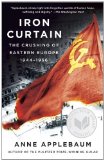Summary | Excerpt | Reviews | Beyond the Book | Readalikes | Genres & Themes | Author Bio

Critics' Opinion:
Readers' Opinion:
First Published:
Oct 2012, 608 pages
Paperback:
Aug 2013, 640 pages
 Book Reviewed by:
Book Reviewed by:
Kim Kovacs
Buy This Book
Introduction
'From Stettin in the Baltic to Trieste in the Adriatic, an iron curtain has descended across the Continent. Behind that line lie all the capitals of the ancient states of Central and Eastern Europe. Warsaw, Berlin, Prague, Vienna, Budapest, Belgrade, Bucharest and Sofia, all these famous cities and the populations around them lie in what I must call the Soviet sphere, and all are subject in one form or another, not only to Soviet influence but to a very high and, in many cases, increasing measure of control from Moscow.'
Winston Churchill, Fulton, Missouri, 5 March 1946
Among many other things, the year 1945 marked one of the most extraordinary population movements in European history. All across the continent, hundreds of thousands of people were returning from Soviet exile, from forced labour in Germany, from concentration camps and prisoner of war camps, from hiding places and refuges of all kinds. The roads, footpaths, tracks and trains were crammed full of ragged, hungry, dirty people.
The scenes in the railway stations were particularly horrific to behold. Starving mothers, sick children and sometimes entire families camped on filthy cement floors for days on end, waiting for the next available train. Epidemics and starvation threatened to engulf them. But in the city of Lodz, in central Poland, a group of women determined to prevent further tragedy. Led by former members of the Liga Kobiet, the Polish Women's League, a charitable and patriotic organization founded in 1913 , the women got to work. At the Lodz train station, Women's League activists set up a shelter for women and children, supplying them with hot food, medicine and blankets, as well as volunteers and nurses.
In the spring of 1945 , the motives of these women were the same as they would have been in 1925 or 1935 . They were witnesses to a social emergency. They organized themselves in order to help. No one asked them, ordered them, or paid them to do so. Janina Suska, in her late eighties when I met her, told me that she remembered these early efforts in Lodz as completely apolitical: 'No one received money for charitable work . . . everyone who had a free minute helped.' Beyond aiding desperate travellers, the Lodz Women's League, in its initial incarnation, had no political agenda.
Five years passed. By 1950 , the Polish Women's League had become something very different. It had a Warsaw headquarters. It had a centralized, national governing body, which could and did dissolve local branches that failed to follow orders. It had a General Secretary, Izolda Kowalska-Kiryluk, who described the League's primary tasks not in charitable, patriotic terms, but using political, ideological language: 'We must deepen our organizational work and mobilize a broad group of active women, educating and shaping them into conscious social activists. Every day we must raise the level of women's social consciousness and join the grand assignment of the social reconstruction of People's Poland into Socialist Poland.'
The Women's League also held national congresses, like the one in 1951 where Zofia Wasilkowska, then the organization's vice-president, openly laid out a political agenda: 'The League's main, statutory form of activism is educational, enlightening work . . . increasing women's consciousness to an incomparably higher level and mobilizing women to the most complete realization of the goals of the Six-Year Plan.' By 1950, in other words, the Polish Women's League had effectively become the women's section of the Polish communist party. In this capacity, the League encouraged women to follow the party's line in matters of politics and international relations. It encouraged women to march in May Day parades and to sign petitions denouncing Western imperialism. It employed teams of agitators, who attended courses and learned how to spread the party's message further. Anyone who objected to any of this – anyone who refused, for example, to march in the May Day parades or attend the celebrations for Stalin's birthday – could be kicked out of the Women's League, and some were. Others resigned. Those who remained were no longer volunteers but bureaucrats, working in the service of the state and the communist party.
Excerpted from Iron Curtain by Anne Applebaum. Copyright © 2012 by Anne Applebaum. Excerpted by permission of Doubleday. All rights reserved. No part of this excerpt may be reproduced or reprinted without permission in writing from the publisher.





The Funeral Cryer by Wenyan Lu
Debut novelist Wenyan Lu brings us this witty yet profound story about one woman's midlife reawakening in contemporary rural China.
Your guide toexceptional books
BookBrowse seeks out and recommends the best in contemporary fiction and nonfiction—books that not only engage and entertain but also deepen our understanding of ourselves and the world around us.